
Original Link: https://www.anandtech.com/show/2616
AMD Radeon HD 4670: Ruling from Top to Bottom
by Derek Wilson on September 10, 2008 12:00 AM EST- Posted in
- GPUs
When AMD released its Radeon HD 4870 and 4850 the price/performance advantage over NVIDIA at the time was so great that we wondered if it would extend to other GPUs based on the same architecture. Inevitably AMD would offer cost reduced versions of the 4800 series and today we're seeing the first example of that; meet the RV730 XT, otherwise known as the Radeon HD 4670:
The Radeon HD 4670 is priced at $79, which in the past hasn't really gotten you a very good gaming experience regardless of who made the chip. Today's launch is pretty interesting because the 4670 has the same number of stream processors as the Radeon HD 3870 (320), which at the time of its launch was reasonably competitive in the $180 - $200 range. Let's have a closer look at the 4670's specs:
| ATI Radeon HD 4870 | ATI Radeon HD 4850 | ATI Radeon HD 4670 | ATI Radeon HD 4650 | ATI Radeon HD 3870 | |
| Stream Processors | 800 | 800 | 320 | 320 | 320 |
| Texture Units | 40 | 40 | 32 | 32 | 16 |
| ROPs | 16 | 16 | 8 | 8 | 16 |
| Core Clock | 750MHz | 625MHz | 750MHz | 600MHz | 775MHz+ |
| Memory Clock | 900MHz (3600MHz data rate) GDDR5 | 993MHz (1986MHz data rate) GDDR3 |
1000MHz (2000MHz data rate) GDDR3 or 900MHz (1800MHz data rate) DDR3 |
500MHz (1000MHz data rate) DDR2 | 1125MHz (2250MHz data rate) GDDR3 |
| Memory Bus Width | 256-bit | 256-bit | 128-bit | 128-bit | 256-bit |
| Frame Buffer | 512MB | 512MB | 512MB GDDR3 or 1GB DDR3 | 512MB | 512MB |
| Transistor Count | 956M | 956M | 514M | 514M | 666M |
| Die Size | 260 mm2 | 260 mm2 | 146 mm2 | 146 mm2 | 190 mm2 |
| Manufacturing Process | TSMC 55nm | TSMC 55nm | TSMC 55nm | TSMC 55nm | TSMC 55nm |
| MSRP Price Point | $299 | $199 | $79 | $69 | $199 |
| Current Street Price | $270 | $170 | $80 | N/A |
$110 |
Clock speeds are a bit lower and we've got much less memory bandwidth, but the hardware has some advantages. The RV730 XT is a derivative of the GPU in the 4800 series cards, and it carries over some of the benefits we saw inherent in the architecture changes. Of these, antialiasing saw a major benefit, but we also see changes like increases in cache sizes, texturing power, and z/stencil ability. We won't see performance on par with the 3870 in general, but the 4670 will do some damage in certain situations, especially if AA comes into play.

AMD is also announcing (but we're not testing) the Radeon HD 4650 running at a meager 600MHz and using 500MHz DDR2 memory. The 4650 will chop another $10 off the 4670's pricetag.

AMD lists board power of the 4670 and 4650 at 59W and 48W respectively and obviously they're single slot (with no PCIe power required). To make things better, both of them include the same 8-channel LPCM support for HDMI from the 4800 series. We're waiting to sort out some issues with HDCP and our latest test version of PowerDVD Ultra before confirming the support, but we know first hand that it works on the 4800 series and we see no reason that it wouldn't on the 4600 series.
We are quite happy to see AMD pushing it's latest generation technology out across its entire product line. It's great to see new parts making their way into the market rather than a bunch of old cards with slight tweaks and new names. Of course, AMD is fighting back from a disadvantage, so they don't have the luxury of relying on their previous generation hardware to trickle down the same way NVIDIA can. But we certainly hope that AMD continues to follow this sort of trend, as the past couple years have been very hard on the lower end of the spectrum with a huge lag between the introduction of a new architecture and its availability in the mainstream market.
Also of interest is the fact that AMD has added support in the RV730 for 900 MHz DDR3. The move away from GDDR3 toward the currently ramping up and dropping in price system memory solution is quite cool. Let's take a look at that in a little more depth.
Non-G DDR3? Sure, Why Not
For a while now we've been seeing either DDR2 or GDDR3 on most graphics cards. The future standard looks to be GDDR5 at this point (with 4 being skipped due to its not-that-much-better-ness when compared to GDDR3), but currently board makers are faced with an interesting situation: DDR3 is coming down in price due to its adoption on the desktop.
The push to GDDR3 was to fill the need in the graphics industry for faster DRAM, so it came along a little ahead of DDR3 and has served us well for the past few years. DDR3 is now finding traction in the desktop world and prices are starting to come down as every major platform will support DDR3 going forward. Performance is apparently fairly similar at the speeds DDR3 can hit (we don't really have a way of testing this ourselves right now, but this is what AMD is telling us), so price is really the only differentiator.

The future: GDDR5 at the high end and DDR3 at the low end for graphics cards
Cheaper DRAM means cheaper boards, especially on the low end where we won't see really high speeds where GDDR3 or GDDR5 would be required. This is a good thing as it will hopefully bring performance down to the mainstream faster.
Enter the 8800 GS ... err ... I Mean The 9600 GSO
Recently, we tested the 9500 GT, which is really just a slightly overclocked, die shrunk version of the 8600 GT. We do see that kind of thing as newer models get pushed out, and it makes economic sense. If you can die shrink something and sell it for the same price and a little more performance, you'll make more money. There have been times where we've seen the specs of a part change and the name stays the same, which is a little annoying, but we also get why that happens.
But this is a little extreme. The 9600 GSO is an 8800 GS with a different sticker. Yep, that's it. Same GPU, same board, same everything. The name is the only difference. I don't think I could manage enough sarcasm to even try and make fun of this one properly. Sorry.
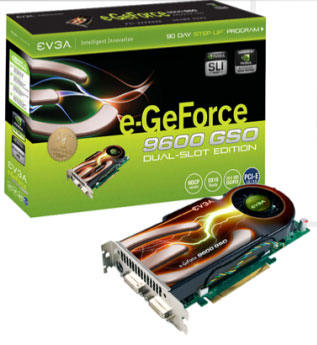
Anyway, the 9600 GSO is a $90-$110 part. Sure you can spend even more if you want an overclocked version, but this is the general range. So why are we looking at this for a $70-$80 price range review? Well, it's not that much more expensive, really, and that hasn't stopped us from including things in the past. Especially because, at these prices, spending just a little bit more gets you much much more for you money (usually). Since we already know the 9500 GT is a little under powered for its price point, we wanted to see what else NVIDIA had up their sleeve in the price vicinity.
There is the added complication that a 9600 GT can be had for about $100 as well. There is already a lot of data here and we don't want to go cluttering up our charts with cards that aren't really in the same price class (yes this is ~20% more expensive than the 4670 suggested pricing). The 9600 GT, though, is fairly competitive with the 3870 which we do include for an architectural reference. Based on this, we can talk about the relative value fairly easily.
The prices on sub $100 market hardware are volatile, and fairly close together. Honestly, as is generally the case, we'd rather spend just a little bit more money and get a lot more value. But at some point there needs to be a cut off, so we'll still look at who comes out on top in the $70 - $80 space and we'll also try to talk about whether that's good enough to save the extra cash.
Either way it is really important to emphasize that people need to look at current pricing when they are buying hardware. Things fluctuate a lot in the market, and we are going to report as many relevant performance numbers as time allows. Take performance and the best price you can find at the time and factor them both into your decision. While our conclusions on relative value may be most relevant close to the time they are published, there will always be deals to be had that change things up. Currently there are some mail-in rebate offers that make the 9600 GSO more price competitive with the 4670, so don't forget to shop around.
Is Antialiasing the Killer App?
We tend to only touch briefly on antialiasing on the low end, more as a side show than for any serious purpose. Many older games can run on lower end hardware with AA enabled, but most newer games tend to chug to a halt if any decent level of quality has been enabled alongside AA. Will this launch be any different?
Back when we first looked at AMD's new RV7xx architecture, we noted quite a large improvement in antialiasing performance over their previous generation. Part of this, of course, is due to the major issues R6xx and RV6xx hardware had with antialiasing performance. Yet still, we felt it quite important to do a little deeper digging to find out if there was some possibility that up to 1280x1024 the 4670 might be able to run with 4xAA enabled in games.
Why do we care about AA on this hardware? Well, in spite of the fact that performing antialiasing adds a lot of overhead, the quality benefit is most apparent (and important) at lower resolutions. The larger a pixel is on the screen, the more aliased (jagged) edges look. It's easy to understand when we think about building blocks: if I build the same castle out of the huge toddler sized duplo blocks and standard lego blocks, one is going to look a lot more natural and smooth than the other. Antialiasing would be kind of like making the corners of some blocks a little bit transparent. This doesn't really have a real world analog, but I think that's the best way to get it across. The point is that the castle that already looks pretty smooth will look a little smoother, while the really blocky looking castle will look a lot smoother.
Small rabbit hole here: the real long-term solution to image quality is not AA, it is increasing DPI (dots per inch). Decreasing the size of a pixel will do a lot more to make an image look smooth than any amount of antialiasing could. What's the analog in the real world? Compare those duplo and lego castles to a sand castle. Many more grains of sand that are much smaller mean a very very smooth appearance with no AA needed. Display technology has severely fallen short over the past few years and we still don't have desktop LCD panels that really compete with top of the line CRTs from 7 or 8 years ago.
Anyway, the point is that if these cards that can't run at very high resolutions are paired with a low resolution monitor (say 1024x768 or 1280x1024), we would really see some benefit from enabling AA due to the large pixel sizes. The feature is more important here than at the high end, and we could get a significantly better experience on this hardware if we had the benefit of AA. The question is: can the improvements that AMD made to their AA hardware translate into large enough performance gains in the 4670 over competing hardware to justify the use of antialiasing in games?
Let's keep an eye out for answers as we look at our test results.
Test Descriptions and Settings
Age of Conan
For Age of Conan, we opened up the graphics settings and clicked the high button. For added fun we went into the advanced page and upgraded to SM 3.0, though nothing else on this page was changed. We left AA off, as the graphics on this one were a bit tough already, and getting a good experience might require dropping down to medium settings. It's a shame that AoC doesn't allow us to test at 800x600. On an MMO, screen space can be pretty important, so we do understand the decision. Our tests consist of a swim towards Tortage Island and a quick run to the jungle. The test is a straight line run and very repeatable. We used FRAPS to record the average frame rate.
Enemy Territory: Quake Wars
We recorded a custom net timedemo for this one. All of our tests are done using the highest possible settings with 4xAA. The Doom 3 engine is getting a little outdated and just about everything can run it well. One of the more interesting issues is that we need to quit out of the game every time we change resolution or our scores get really crazy.
Race Driver: GRID
This game plays surprisingly well at lower resolutions on these cards. We used the ultra high settings, but disabled AA here. Some of the shaders this game uses really benefit from AA though, and the 4670 is actually able to handle AA pretty well on this one at 1280x1024. The test for GRID is the first straight (right into a wall) of a track. We start at the back of the pack and start FRAPS running as soon as we take off. FRAPS is stopped when we hit the wall.
The Elder Scrolls IV: Oblivion
This test has been with us in some way or another for a very long time. The game is DX9, and we use Ultra High default settings for this one. For our AA/AF testing, we force those options through the driver control panel. The test is a straight line run with FRAPS. Even though there's a little age on this game, it is still a great title to get people hooked on gaming. It's open and fun and it doesn't look bad at lower resolutions with the settings cranked up. And these little cards can deliver as well.
Crysis
Yes, the obligatory Crysis test. This one is done using Medium settings across the board and no AA. We were running in DX10 mode and 64-bit as well. Our test is the built-in GPU benchmark run 3 times, and our score is the average of the second two runs. The game does lose some of its luster under Medium settings, but it is still very playable. Depending on the card you have, you would want to spend some time seeing what settings you could get away with pushing up to High.
The Witcher
For The Witcher we crank everything way up. We would have done more AA tests with this one, but there is this annoying new trend of limiting the maximum resolution AA can be enabled on based on framebuffer size. Aside from being annoying in our testing, architecture has a lot to do with AA performance and framebuffer is sort of a naive metric to use. In any case, this is another FRAPS test, but we benchmark one of the early in-engine cut scenes
| Test Setup | |
| CPU | Intel Core 2 Extreme QX9770 @ 3.20GHz |
| Motherboard | EVGA nForce 790i SLI Intel DX48BT2 |
| Video Cards |
ATI Radeon HD 4870 |
| Video Drivers | Catalyst Press Driver 8.9 Beta (Radeon HD 4670) Catalyst 8.7 (Radeon HD 4850, 3850) Catalyst 8.8 (Radeon HD 4870, 3870) ForceWare 175.19 (9600 GSO) ForceWare 175.16 (9500 GT) |
| Hard Drive | Seagate 7200.9 120GB 8MB 7200RPM |
| RAM | 4 x 1GB Corsair DDR3-1333 7-7-7-20 |
| Operating System | Windows Vista Ultimate 64-bit SP1 |
| PSU | PC Power & Cooling Turbo Cool 1200W |
Starting at the Low End: Radeon HD 4670 vs. 3650
Our first comparison is going to be with last year's mainstream part. The 4670 is the direct replacement for the 3650 (as there was no 3670), and the new part easily blows away its predecessor. We saw last week that even the 9500 GT managed to beat that old thing though, so it's good to see this isn't even close to an issue.
I hope you'll excuse me for not commenting on each benchmark here: the data really speaks for itself. There is no question that the 4670 blows the doors off the 3650 and enables a whole lot more playable resolutions and settings.
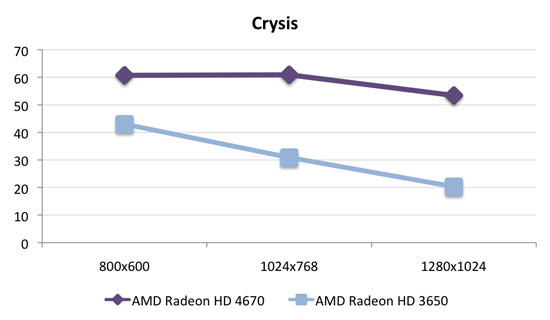
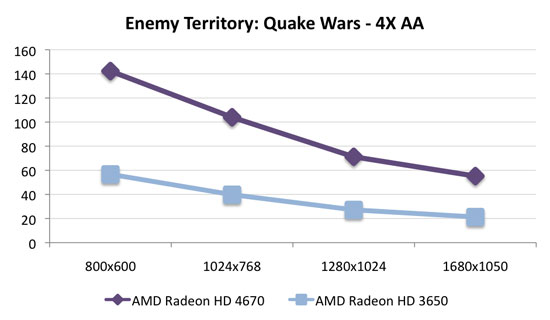
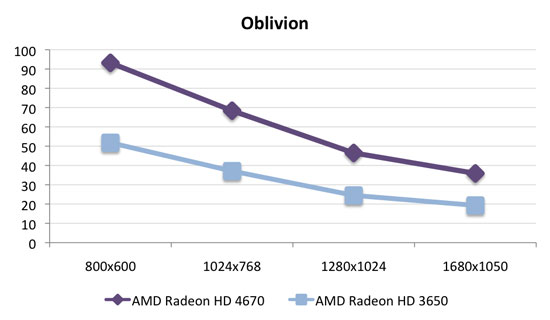
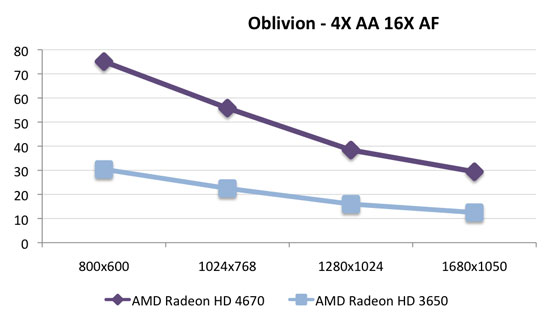
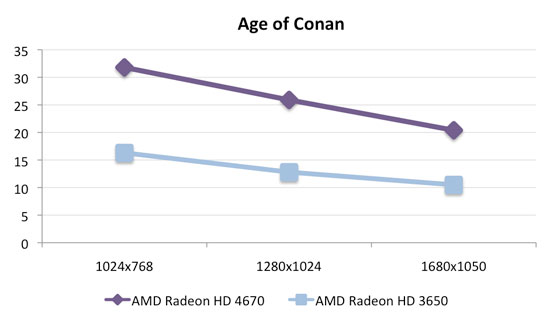
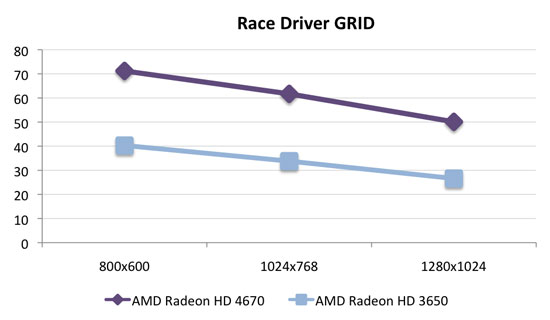
Radeon HD 4670 vs. Last Year's $200 Offerings: The 3870/3850 Revisited
This is an interesting comparison. We included the 3850 in our 9500 GT article, as it was a fairly popular part that had fallen to $100. This time around we throw in the 3870 in order to see how the reduced clock speed and architectural changes impact performance. Let's take a look at the mayhem.
The 4670 really takes the 3850 to task under Crysis with medium settings. Impressively, the 4670 stays above 30 fps at 1920x1200 and does a fair job of paralleling the performance of the 3870 at about a 10fps deficit after 1280x1024.
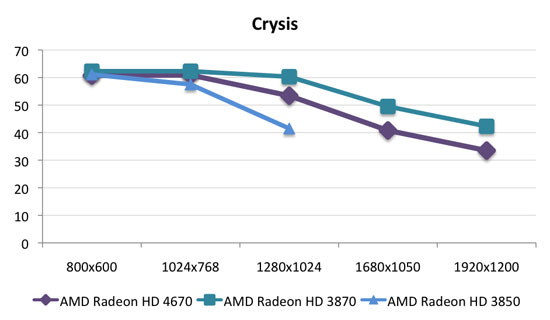
Our Enemy Territory benchmark has everything maxed out plus a little 4x antialiasing action. At low res, the 4670 actually leads the pack here. This is quite impressive and is our first inkling that maybe our hope about AA performance will prevail. The increased ROP power of the 4670 might also have an impact here, but either way this isn't a bad showing.
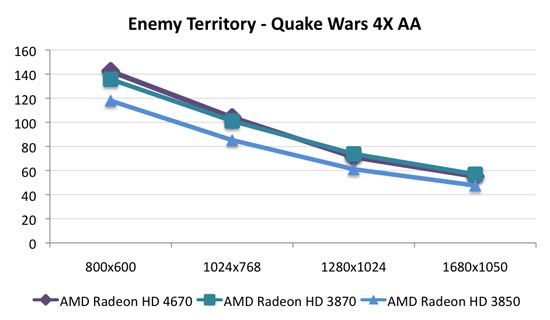
Both the 3870 and 3850 lead the 4670 in Oblivion with ultra high defaults and no AA. The 4670 remains playable up through 1680x1050, which is quite nice. But nothing really interesting happens until we consider what happens when we flick on the AA switch.

With 4xAA and 16xAF enabled, the tables are turned and the 4670 jumps on top. Staying barely playable at 1680x1050 with 4xAA (we'd still recommend dropping back to 1280x1024 though), the 4670 certainly looks to be on pace for delivering mainstream hardware with usable AA for resolutions that really need it while running at high quality settings.
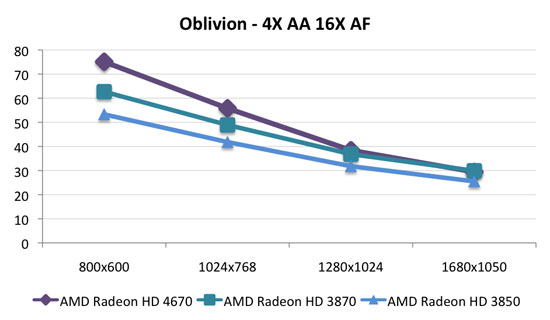
With Age of Conan, 1024x768 is really the highest res we can manage on the 4670 with high quality. The card performs similarly to the 3850 here.
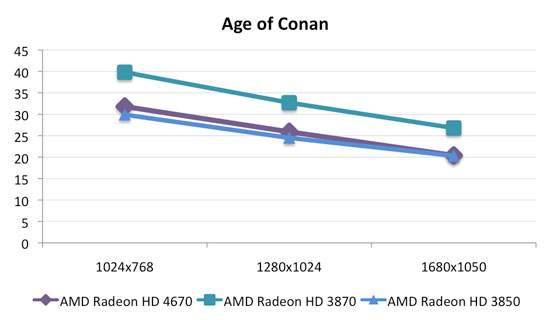
While AoC and GRID are ruled by the 4850 and 4870, the 4670 does lag the 3800 series cards. The game is still incredibly playable at 1280x1024 and we'll have to explore AA in this game a little later on as well.

Last is a look at Crysis with high quality settings (and very high quality shaders). This is a tough benchmark and we only compared the 4670 against the 3870 here. The 4670 can't quite attain playability at 1280x1024 either. Looks like something between medium and high quality would suit the 4670 best.

ATI vs. NVIDIA Once Again: 4670 vs 9500 GT & 9600 GSO
Now we get into the real competition. We're looking at AMD's newest mainstream card vs. NVIDIA's two latest entries into the sub $100 market. The 9600 GSO is just an 8800 GS. Though we didn't compare it here, the 9600 GT is priced right around $100 and offers performance a little better than the 9600 GSO. While we are comparing with the 9500 GT here, it will become quickly apparent that the card doesn't even come close to competing with the 4670.
For our medium quality Crysis test, the 4670 seems framelimited at about 60 here, while the 9600 GSO seems to push past the 60 fps barrier. At 1280x1024 and above, the 4670 leads the pack by a small margin in this benchmark.
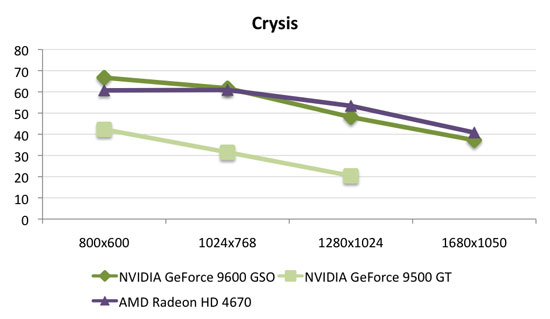
Enemy Territory with 4xAA enabled shows a huge advantage for the 4670 over NVIDIA's more expensive 9600 GSO. Even so, the NVIDIA cards remain playable at 1280x1024, so the practical advantage is a little decreased until we get to 1680x1050.
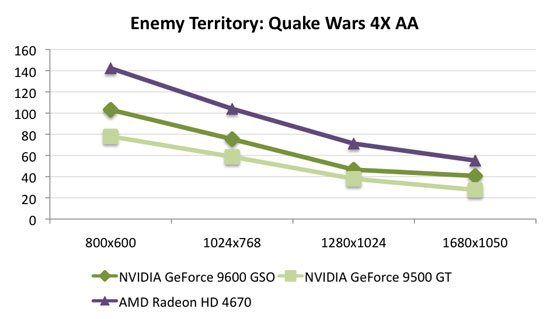
Once again Oblivion offers us a role reversal when AA is enabled. Without AA, the 4670 falls behind above 1024x768, while it pulls a little ahead when 4xAA is enabled. Again, the 4670 and 9600 GSO are playable at 1280x1024 with AA, and might both be passable at 1680x1050 as well (Oblivion is a game that still offers a good experience at anything above 25 fps).
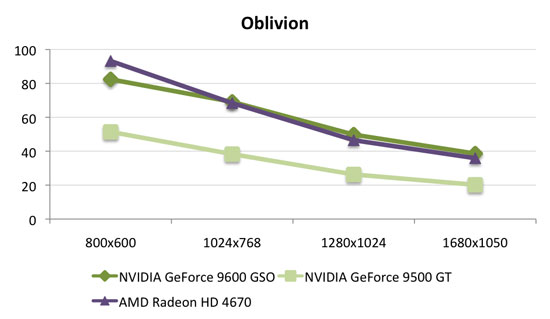

The 9600 GSO maintains a steady ~10% lead over the 4670 in Age of Conan. This is quite an interesting benchmark for NVIDIA to lead considering how handily they are clobbered at higher price points by the 4850 and 4870.

Performance in GRID is nearly identical between the 4670 and 9600 GSO.

Throw AA in there and we see a little separation trying to happen, but the 9600 GSO actually does keep up at lower resolutions with AA.
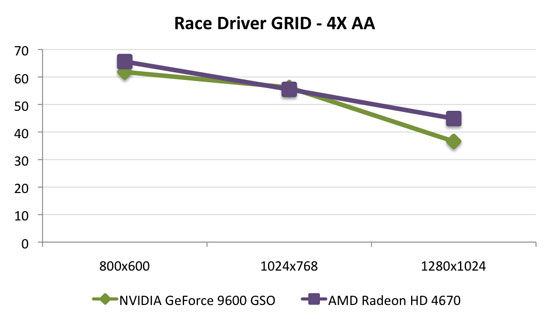
For The Witcher, while the 4670 leads at lower resolutions, performance converges at higher res. Both are playable at 1280x1024. We wanted to test AA in this one, but it is sort of difficult as the game limits the ability to enable AA based on framebuffer sizes; thus we couldn't enable 4xAA past 1024x768 on the 9600 GSO.
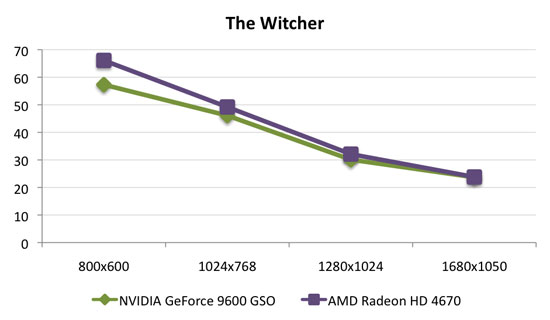
When we hit high quality Crysis, the 4670 leads.

And the lead just gets bigger if we look at medium quality (high quality shaders) with 4xAA enabled. The 4670 is borderline playable in this situation at 1280x1024 while the 9600 GSO falls way short.
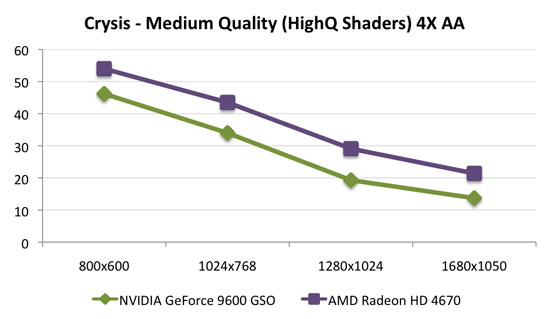
What You Get for Your Money: 4870 vs 4850 vs 4670
We collected a bit of data on the current 4k series lineup to show a little about what we get for each price point. This data doesn't really tell the whole story, though it does shed some light on relative performance for those who want to know where their money is going.
The real value in these higher priced, higher performance cards isn't in how much faster they can do the same thing as the 4670, but in how much higher a resolution they can hit while doing it. While there are some cases where the 4670 might be able to barely remain playable at 1680x1050, the 4850 is really going to be a better option there and at 1920x1200. Likewise, the 4870 is going to benefit people who have a 30" display or don't like playing without every option ticked and tweaked to the max on the very latest titles.
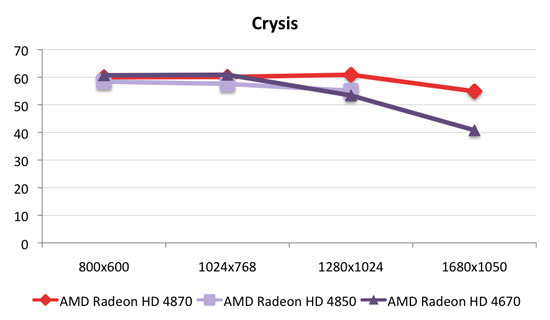
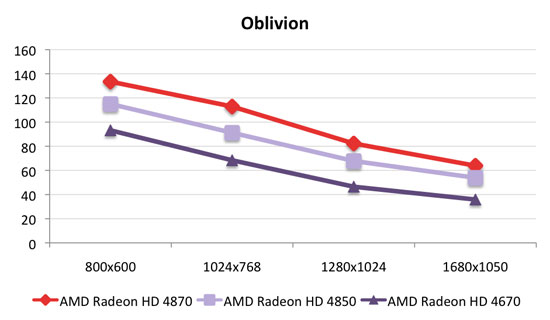
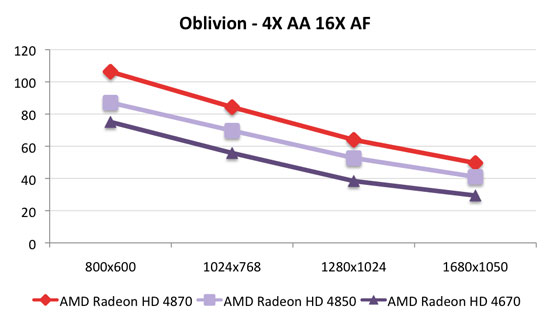
Power Consumption
When it comes to power consumption, the Radeon HD 4670 is nothing short of awesome. At idle our entire testbed (Intel G45 + Core 2 Quad Q9450) used only 67W with the Radeon HD 4670. Under load running Crysis we were looking at 139W.
While the 9500 GT is a little lower in power use, the performance difference is huge as well. The 4670 drawing 139W competes in performance with the cards that draw about 30W more.
The card isn't passively cooled, but it is fairly quiet. For those who don't need absolute silence and want an HTPC that doubles as a gaming machine on a 720p TV, the 4670 might be the ticket.
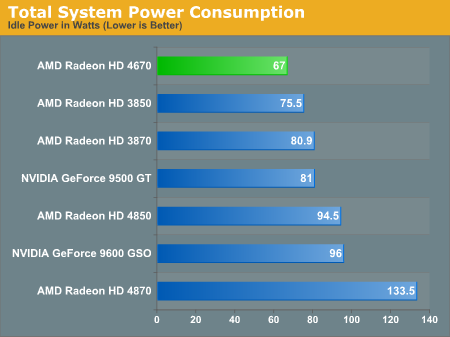
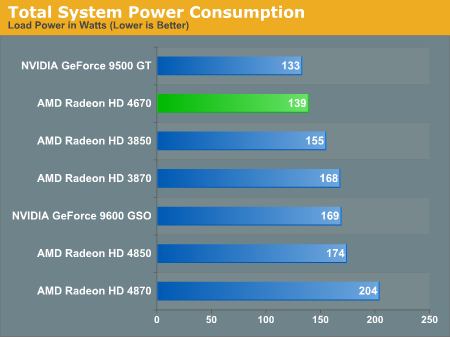
The Charts
If you prefer having all of the data in individual bar graphs, here you go.
These graphs are collected from our 1280x1024 data. The 4670 leads its competition more often than not, including the more expensive 9600 GSO. There are a couple times where the NVIDIA part pulls ahead, but it's clear that the 4670 would be a better value even if the 9600 GSO hit the same price point.
Additionally, for the 4670, only two of these numbers are less than playable and one is borderline. In general, the 4670 shows that at 1280x1024, it can handle all the current games you might throw at it. In the tests where AA is enabled, the 4670 shows that it has an added advantage, which matters much more at low resolutions than high ones.
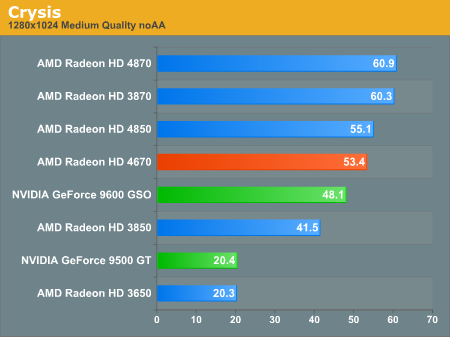
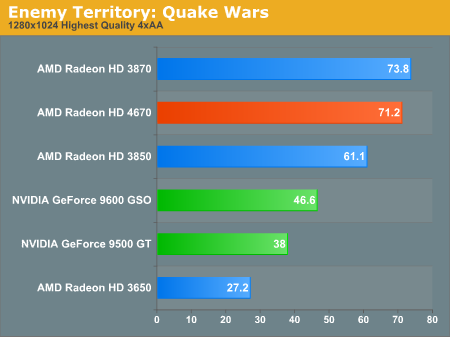
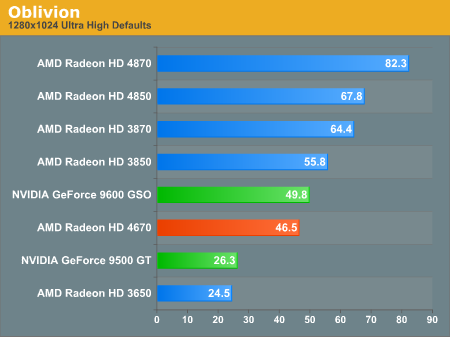

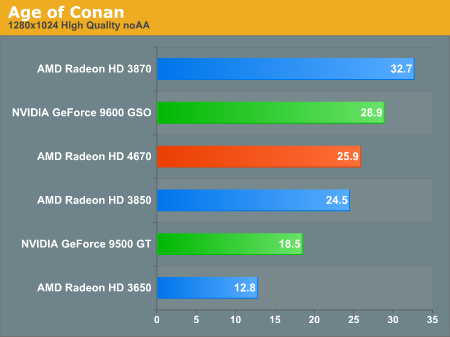
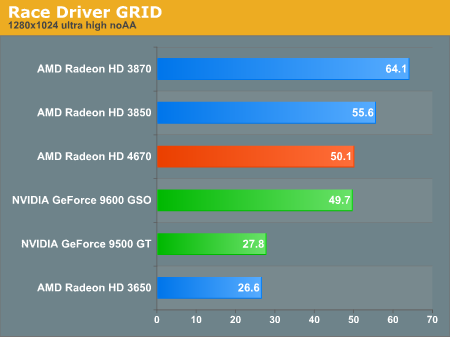
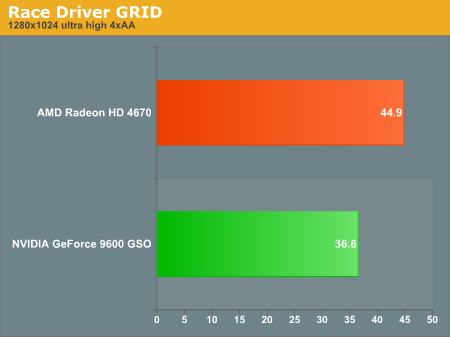
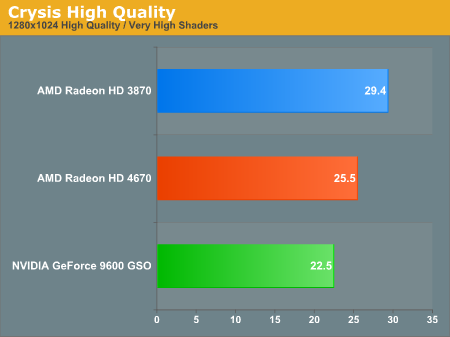
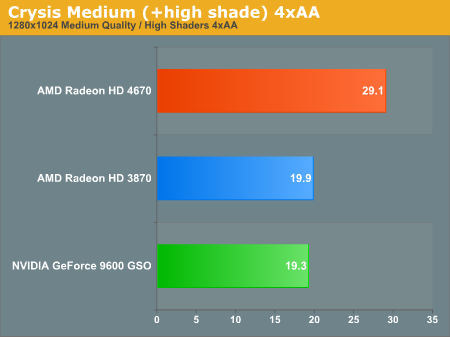
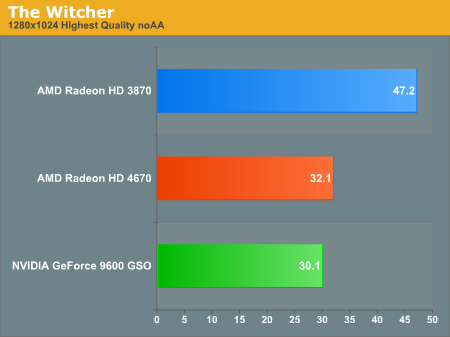
Final Words
When the Radeon HD 4870 and 4850 hit the scene, they were simply the best cards at or near their price points. Their release caused major price drops on NVIDIA hardware and really shook up the market. The question is: is the Radeon HD 4670 something like a 4850 for the sub $100 market? Unfortunately, that's a more difficult question to answer than it was with the higher end parts. Yes the 4670 outperforms the 9500 GT, and where it doesn't out perform the 9600 GSO it is competitive. So what's the problem?
The 3850 trails behind sometimes, but the 3870 generally maintains a performance lead. You can now find 3870 starting at around $100 (GeForce 9600 GT also falls into this category), and we'd rather spend the extra bit of cash and get added performance. (Ed: Updated to reflect current prices.) The value is still lower at a lower price than other hardware that's more expensive. We pointed out this problem in our recent 9500 GT review as well: spending less money gets you disproportionately less performance. It's similar to how we see diminishing returns for increased spending at the very high end.
The 4670 doesn't change the game enough to say that spending more money isn't worth it, but the 4670 does lead at its price point and is good enough for anyone with a 1280x1024 monitor to have a good experience. We even see some advantages that would allow us to enable 4xAA at these low resolutions and enjoy playable performance. This card isn't going to change the world, but it fits a niche. Throw in the lower power requirements and smaller form factor and you have a great card for moderate gaming.
Unlike the 9500 GT, this card isn't an epic fail at its price point. We would still like more (we always do), but what we've got isn't bad. This is hardware based on a new architecture (meaning it has all the latest features and bug fixes like working AA hardware), unlike NVIDIA's competitive offerings. We can play most of the games we tested at 1280x1024 (a very cheap very widely used panel size) with high quality settings and some of them do well with 4xAA enabled as well.
So this (almost) rounds out a top to bottom RV7xx lineup from AMD - we're still waiting on one more part. The hardware does outperform the competition at the same price point (though that isn't saying much), and we even get playable performance at 1280x1024 (a key target resolution for budget systems). If you want gaming performance first, however, you will still need a more powerful GPU - we'd recommend spending a little bit more like the HD 3870, 9600 GT, or 8800 GT, and if you can swing it the HD 4850 and 9800 GTX+ offer excellent performance at the $180 price point. On the other hand, the 4670 works great as a Jack of all trades.
In light of all that, what's the verdict? If you just can't spend that extra ~$20, this is absolutely the card to buy right now. This might be the 4850 or 4870 of the sub $100 market, but the problem is that the sub $100 market still doesn't provide the kind of gaming performance we would like to see compared to the rest of the market. It's easy to argue that people pay a premium for the best performance out there, but it just doesn't make sense on the lower end. For the people who need a card that fits this niche and price point, the 4670 is the card to pick up unless there's a great sale or rebate offered on a higher performing part. With lower prices, small fluctuations can really stir things up. But the 4670 gets our nod when it comes to current street prices and AMD's suggested pricing.











